President's Message
We hope you can join us for the "Homefront Tribute," a free event to be held on Saturday, September 2 at the Sandston Memorial Recreation Center to commemorate the 75th anniversary of our entry into WWII. It is very heart-warming that the community has come forward to do their part, just as they did in the 1940s to support the troops and the war effort.
The Henrico County Concert Band, directed by Randy Abernathy, will give a patriotic themed performance (guaranteed to give you goosebumps). Uncle Sam and Rosie the Riveter will be there to greet you. There will be a march of honor for those who served in WWII. The Henrico Extension Service Master Gardeners will give tips on planting a garden; Keep Henrico Beautiful will give tips on recycling; the USO and the American Red Cross will have representatves of their organizations. Joe Enroughty and His Royal Virginians will perform for a dance contest. If you don't dance you can be a spectator or a judge. Dr. Henry Nelson, whose family has lived in the Varina District for generations, will bring antique cars of the era from his private collection. Refreshments will be provided by the community.
Come dressed in the styles of the 1940s or come as you dress 75 years later. And don't forget to bring your WWII related documents to be scanned or photographed.
This effort to collect WWII history launches an HCHS project to record family history. There are lots of stories within the communities out there about how citizens made Henrico what it is today.
We hope you will also join us for our quarterly meeting at the Richmond Railroad Museum. Railroads were very strategic in transporting troops not only during WWII but also dating from the American Civil War.
Prior to the Civil War, railroads were already prominent in Henrico history as a means to transport resources such as coal from the mines in Henrico in the 19th century. Trains were more reliable than the former methods of wagons and waterways and not subject to seasonal weather conditions when the waterways would sometimes freeze. The Industial Revolution was underway and railroads provided the means for rapid economic growth.
Come learn all about it and bring your family and friends.
Visitors are always welcome.
Sarah Pace
President
>Back to Top<
Homefront Tribute
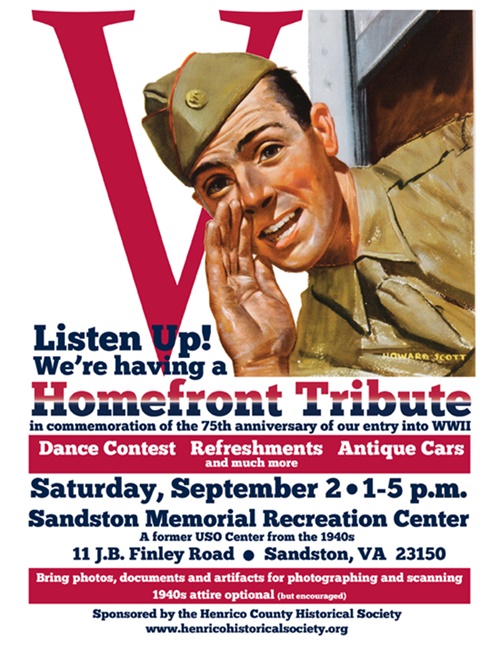
How to Get There:
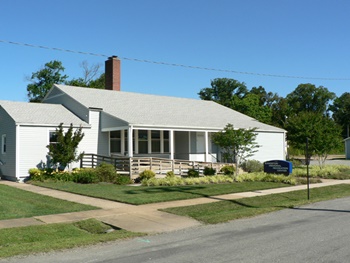
Photo courtesy of Sandston Memorial Recreation Center.
Sandston Memorial Recreation Center
11 J.B. Finley Road
Sandston, VA 23150
From Interstate 64:
Take Interstate 64 to the Sandston/Airport exit. Move to the far left lane while going down to the second light which is Williamsburg Road (Route 60). Turn left and go down about .8 mile. Take the next left after passing the Post Office onto J.B. Finley Road; the SMRC is the first blue building on the left.
From Interstate 295:
Take Interstate 295 to the Highland Springs/Airport exit. Go through three lights (Washington Street, Nine Mile Road, & Audobon Drive). Move to the far left lane while going down to the fourth light which is Williamsburg Road (Route 60). Turn left and go down about .8 mile. Take the next left after passing the Post Office onto J.B. Finley Road; the SMRC is the 1st blue building on the left.
>Back to Top<
September Quarterly Meeting
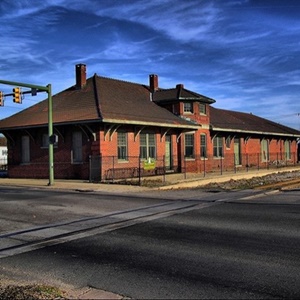
Come and hear about Richmond's railroad history and tour the Richmond Railroad Museum! Our next meeting will be held on Sunday, September 10th, starting at 2:30pm. The Richmond Railroad Museum is located at 102 Hull Street in Richmond, VA 23224.

The Richmond Railroad Museum is located just over the 14th Street Bridge on the left as you head south. Park inside the fenced area on the north side of the museum.
Nominee for Director of the Varina District - Dana Hansen - to be approved at HCHS September meeting.
>Back to Top<
Henrico Character Sketches
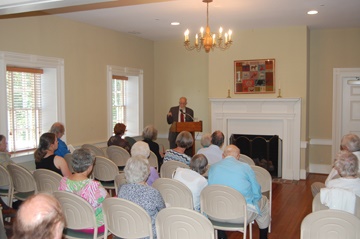
Dr. Louis Manarin entertains Henrico County Historical Society members with his stories of colorful characters during the June meeting held at Walkerton Tavern.
>Back to Top<
The Payne Limner Had Difficulties with Anatomy, But in His Portraits The Eyes Have It
In her novel South Pole Station, Ashley Shelby tells us of her artist-protagonist Cooper Gosling's process of portraiture: "The canvas now in front of her was embryonic, but promising...But she had figured out the eyes, which was the only way into a portrait...She started to paint." Over two hundred years ago, an unidentified, untrained but not unskilled artist seems to have had the same affinity for the eyes of his subjects and one of his works, Alexander Spotswood Payne and His Brother, John Robert Dandridge Payne, with Their Nurse, hangs in a room of eighteenth century American artists on the second floor of the Virginia Museum of Fine Arts. That anonymous artist was an itinerant painter who worked in Henrico and Goochland counties between 1780 and 1803 and produced, among other works, ten portraits of the Archer Payne, Sr. famliy of Gochland, thereby earning him the name "the Payne Limner."
Limner is a term for an untrained artist, and while the Payne Limner's work is clearly the product of an untrained hand marked in part by a lack of understanding of underlying anatomy, his paintings are still rather remarkable. Eliabeth Thompson Lyon says in The Payne Limner, "A forthright and warm affection is evident in his portraits of the two Payne boys and their nurse." I felt that warmth when I returned to the Virginia Museum of Fine Arts to look more closely at that painting that I had looked at many times but never really seen. It was the eyes, clear and focused, that drew me in.
Lyon attributes thirteen paintings to the Payne Limner: the ten Payne family portraits, portraits of the White/Price and White/Cocke families and The Ege-Galt Family Portrait - a painting of four generations of sitters from Richmond and Henrico. Additionally, a January 18, 2017 auction by Nye & Company of Bloomfield, New Jersey, offered five other paintings attributed to the Payne Limner depicting members of the Nicholas Brown Seabrook family who had resided in Richmond and Henrico County. Obviously, none of the paintings are signed; instead, they are connected by stylistic similarities.
Those stylistic markers, according to Lyon, included distortion in the shouders and arms of his subjects, flushed complexion and hands that show little structure, often with a pronounced V-shape between the fingers and a sharply pointed wedge between the thumb and forefinger. The heads of infant subjects seem to swell in the back. A recurring feature in his femaled portraits is a string necklace, a fashionable accessory in the late eighteenth cenury. He often used red to rough in preliminary drawings, and that red is sometimes visible in the finished painting. And he seems to have had a unique method of preparing his canvases, applying the ground in arched sweeps rather than following the weave of the material. I would also add eyes to the list.
Let's start with the Virginia Museum of Fine Arts' Alexander Spotswood Payne and His Brother, John Robert Dandridge Payne, with Their Nurse, a 56" x 69" painting from 1790-91. The eleven-year-old Alexander Spotswood Payne stands at the left holding a bow and arrow in his right hand while he raises his left hand to display the woodpecker he has apparently just shot. His infant brother, John Robert Dandridge Payne, seems to be learning to walk and is stepping in his direction, while their African-American nurse-maid reaches out in an attempt to steady or catch him. Between the two brothers is a pet dog.
The clear, piercing gazes of his subjects, the traits that drew me in, seem to be the most realistically rendered features of the three people, almost at odds with the somewhat awkward renderings of others. For example, distortion of the shouders and arms is evident in the nursemeaid and the infant. Lyon noted that it often appeared as if the Payne Limner chose a placement of the hands and then was forced to lengthen the arm to reach it. That seems apparent in the supporting hand the nurse-maid extends and the uplifted left hand of John Robert Dandridge Payne. The hands of both of them also demonstrate the pointed wedge shape formed by thumb and forefinger. Looking closely at the painting, one can note a faint line of red along the front of the left shin. Nonetheless, as Lyon states, "The lack of anatomical accuracy is compensated for in the truthful and appealing nature of these scenes of daily life.
Four pairs of eyes stare out from slightly flushed faces in the Portrait of the Ege-Galt Family, a 36" x 43 7/7" oil on canvas from the collection of the Abby Aldrich Rockefeller Folk Arts Center in Williamsburg, Virginia. Between 1800 and 1803, the artist whom Elizabeth Lyon believes to be the Payne Limner executed a portrait depicting Maria Dorothea Scherer Ege, Elizabeth Galt Williamson, Frederick Williamson, and Elizabeth Ege Galt; and the subjects have strong local connections. The central figure of the portrait, Elizabeth Galt Williamson had married Thomas Williamson of Henrico County in 1800, and their son Frederick sits in her lap. Elizabeth's husband was the grandson of Mary White Price, a subject of another of the Payne Limner's works, lending credence to Lyon's attribution. Maria Dorothea Sherer Ege, the matriarch at the left, was the wife of Jacob Ege, a German immigrant who built the Old Stone House that now houses the Edgar Allan Poe Museum on Main Street near 20th Street and whose family occupied the house through several generations. It is both possible and sad to estimate a date for the portrait since both the eldest and youngest subjects died in 1803.
Aside from the Williamson-White link, there are stylistic qualities that suuggest the hand of the Payne. The left hand of Elizabeth Wlliamson is quite similar to the left hand of Martha Payne, whose portrait is in the same museum's collection. (It can be seen at http://www.history.org/Foundation/journal/Summer05/images/Pix_41.jpg.There is also significant and similar distortion in both Martha Payne's and Elizabeth Williamson's left shoulders. The artist seems to have placed Elizabeth's left in her son's lap, forcing him to elongate her arm to meet it, just as the Payne Limner had done in the painting of the Payne children. Lyon pointed out that infant's heads seem to swell in the back, and this trait is evident in Frederick Williamson as it was in the depiction of John Robert Dandridge Payne; in fact, those two children's faces and heads are eerily similar. Frederick's left forearm is also disproportionately long.
The anatomical weaknesses, however, seem balanced by the rather sure-handed handling of fabric in the clothing and headwear. On a recent trip to the Abby Aldrich Rockefeller Folk Art Center, I was struck by the eyes of the Martha Payne portrait, which also demonstrated the remnants of the red preliminary sketching along the edge of her right hand. Unfortunately, the Ege-Galt familiy portrait, which is the museum only attributes to an anonymous artist, was not on display, so a direct comparison was not possible. Whomever the original artist was, it is clear that Elizabeth's face was reworked at some later date; however, Lyon's attribution of the original painting to the Payne Limner seems reasonable.
Assuming the Ege-Galt portrait is the work of the Payne Limner, it certainly illustrates a great deal of artistic growth when compared to his earliest productions: five portraits of the Nicholas Brown Seabrook family dating to around 1780. Seabrook was born in Middletown, New Jersey, moved to Portsmouth and then Norfolk, Virginia and then came to Richmond in 1775. He was a sea captain, identified as the master of the Goldfinder, a Virginia brig carrying 8 guns and crew of 25 in 1782. He was also a Richmond merchant and landowner and the owner of a plantation in Hanover County. In a 1782 letter to his brther, Seabrook indicated that in Richmond "I have five half acre Lotts of Ground" and a "Plantation of 727 acres of Land Leying 11 miles out of the Town." His will, proved at Monthly Court of Henrico County on September 7, 1790, identified that land "known by the Plan of the City" as lots AB, C, F and 3, and left them to four of his four children. Seabrook had died that year and is buried at St. John's Church on Church Hill.
In the portrait, Nicholas Seabrook's rather wide-eyed stare looks out from a somewhat cartoonish face. Weaknesses in rendering the anatomy are evident in this early work with the head disproportionately small and the left shoulder typically distorted. Perhaps the Payne Limner was beginning his avocation at the time because this portrait seems to be a direct copy of a watercolor on ivory miniature of Seabrook in the New York Historical Society. Clothing color is changed, but composition, pose, significnant relevant objects are identical. Could the Payne Limner have used this more sophisticated rendering as the model for his portrait as he began a regimen of self-training? If one looks at the Seabrook portraits of 1780, then the Payne portraits of 1790 and finally the Ege-Galt portrait (assuming that it is his), his growth is obvious.
But who was this anonymouse "limner"? Lyon suggests that he may have been a sign, coach and house painter or a gilder. She also offers the possibility of his being a calligrapher because the portrait of Payne's wife displays a meticulously rendered stick pin with the monogram "AP" for Archibald Payne. I also noted this same skill in a pin worn by Alexander Spotswood Payne. And while he was not trained, he was aware of eighteenth century conventions in portraiture, such as the inclusion of ojects significant to the subject - the ship, sword and rifle in the Seaborook protrait and the bow and arrow in the portrait of the Payne children, as well as a selection of pets.
And he seems to have had a symbolic bent. Many of the children's protraits contain a bird, likely symbolic of the freedom of youth. Seabrook's daughter reaches out to pet one, and Frederick Williamson holds a bird. And perhaps the inclusion of the slain woodpecker held aloft by Alexander Payne represented his maturing.
It is unlikely that the identify of the Payne Limner will be found, but that is unimportant. His work is what matters. I want to see all of it that I can, and I will be returning to Williamsburg when the Ege-Galt painting is available for viewing. I'll let you know what I think./p>
Joey Boehling
Alexander Spotswood Payne and His Brother, John Robert Dandridge Payne, with Their Nurse,
ca. 1790-91. Courtesy of the Virginia Museum of Fine Arts, Richmond. Gift of Miss Dorothy Payne. Photo: Katherine Wetzel (c) Virginia Museum of Fine Arts.
Portrait of the Ege-Galt family. 1801-1803. Courtesy of the Abby Aldrich Rockefeller Folk Art Center, Williamsburg, VA.
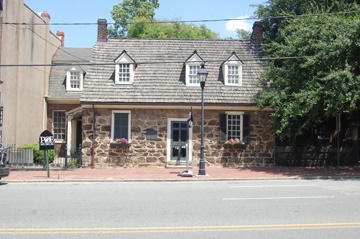
Old Stone House. Now housing the Edgar Allan Poe Museum at 20th and Main Streets in Richmond, the structure was built by Jacob Ege, husband of Maria Sherer Ege (left in family portrait), and is the oldest structure in the city.
Sources Consulted:
Lyon, Elizabeth Thompson. The Payne Limner. Virginia Commonwealth University M.A. Thesis, 1981.
Naval Records of the American Revolution, 1775-1788. Washington Printing Office, 1906.
Stillwell, John E., M.D. Historical and Genealogical Miscellany: Early Settlers of New Jersey and their Descendants. Vol. Iv. New York, 1916.

Portrait of Nicholas Brown Seabrook. ca. 1780. Payne Limner.
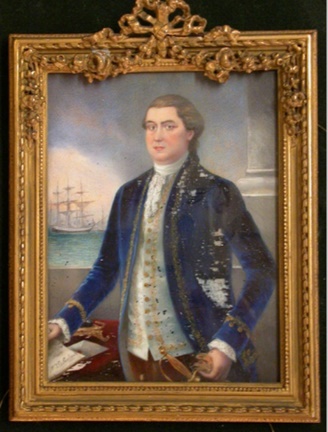
Miniature of Nicholas Brown Seabrook. Artist Unknown. New York Historical Society.
>Back to Top<
Now You Know: Spittin' Image Opens a Window on Keeping Water Cool and Buying Local
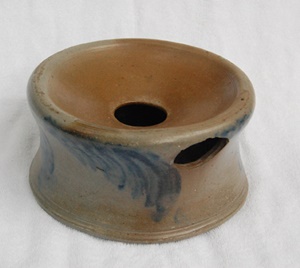
Congratulations go to Margaret Thomas of Historic Buckingham for identifying the object featured in the last issue's "What do you know?" As Ms. Thomas knew, it was a spittoon, and she said she has one just like it. The maker was David Parr of Richmond and his work is part of the James River school.
Past issues of this newsletter have discussed nineteenth century stoneware produced by potters from that school, including Henricoans John Pool Schermerhorn, Thomas Amoss, Samuuel Wilson and Samuel Frayser.
David Parr, who is shown to be living in Richmond, Ward 1 Henrico in the 1860 census, was born in Baltimore. He came to Richmond, and in 1858, partnered with Thomas Keesee, producing stoneware that is very desirable to collectors. After the Civil War, he continued production under the name of Parr & Sons.
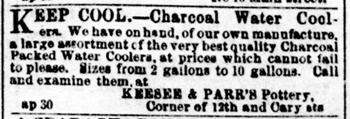
While the pottery is important, some marketing strategies for the products are also interesting. They are precursors to much in today's society: the push to "Buy Local," the ironic humor found in much advertising and our infatuation with water, bottled or filtered. Let's start with one stoneware vessel offered by Keesee & Parr - a charcoal water cooler that in 1859 Daily Dispatch advertisement claimed would help customers "Keep Cool". The advertisement touted the efficacy of the charcoal packing, which, it seems, acted as insulation. The ad also pointedly announced that the coolers were of their own manufacture.
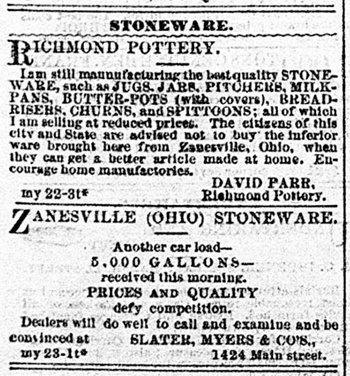
In 1870, Parr was still making charcoal water coolers under the Parr& Sons name, then at No. 8 Fourteenth Street. A Daily Dispatch ad of May 23 of that year made the somewhat hyperbolic claim that the coolers would "keep the same quantity of ice longer than any other cooler in the market." After claiming to "manufacture the best STONEWARE in the United States," Parr's ad goes on to state that the coolers "are selling at less price than the northern potters." It concludes with an appeal to "Encourage home manufactories."
By 1878, the antipathy toward the "northern potters'" had become more specific, singling out the competition from Zanesville, Ohio. A May 24, 1878 ad of Parr's Richmond Pottery was interestingly placed directly above a Slater, Myer & Co. ad announcing the arrival of "Another car load" of Zanesville stoneware. The Parr ad advises citizens "not to buy the inferior ware brought here from Zanesville, Ohio, when they can get a better article made at home." And it again concludes with the appeal to "Encourage home manufactories."

Less than a week later, the two companies advertised again, but the placement was reversed. In the Daily Dispatch of May 29, 1878, the Slater, Myer & Co. ad came first and announced "ANOTHER CAR-LOAD ON THE WAY." A long ad headed simply "POTTERY" appeared directly below it, and while it did not say so directly, it was clearly written by David Parr. Parr stuck his tongue firmly in his cheek and urged Richmonders buy the wares from Zanesville, "no matter about the quality" and to "break up the RICHMOND POTTERY and drive old PARR away." It goes on to praise Parr's humanitarian activities done during the Civil War but added that Parr "is old now and hardly able to pay his debts. We have no further use for him. Let us encourage our Ohio Friends." After pointing out Ohio's aid in defeating the South, he suggests that readers should buy the wares from Zanesville. He concludes his ad as follows: "By so doing we can break up the Richmond Pottery, give this market to our Ohio friends, and then they can charge us double price to make up their losses."
However, Parr had more. About a month later he ran another ad in the Daily Dispatch of July 8, 1878 - this one signed at the bottom. Indicating that the ironic advice offered in May had been ineffective, he announced: "The Zanesville man has not driven me out of business yet. I am still manufacturing STONEWARE JARS, CHURNS, JUGS & C., that I will warrant to hold vinegar. I will advice housekeepers when they buy a jar or churn to ask the storekeeper if he will warrant it to hold vinegar. If he says no, you may be sure it is Ohio ware. I authorize all my customers to give the warranties.
The more things change, the more they remain the same. Almost 150 years later, we have returned to emphasizing local spending, and at least during election cycles, are bombarded by attack ads. Luckily some of the pottery advertised has also lasted 150 yars. Similar ads will likely last another century and a half; we can only hope that there are artisanal items made in the county today that will also be around that long.
Charcoal Water Cooler. These three views show a Baltimore-made stoneware cooler sold at Crocker Farm in Maryland. The individual parts in the second picture are assembled, as seen in the first picture. The third picture shows the filtering element.



>Back to Top<
What Do You Know?
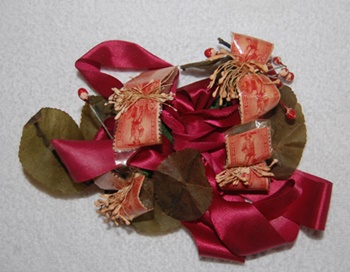
Clearly, the item left is a corsage, though it is a bit worse for wear. In small cellophane packages attached to the item are pink stamps which serve a very important purpose and gave the corsage its purpose.
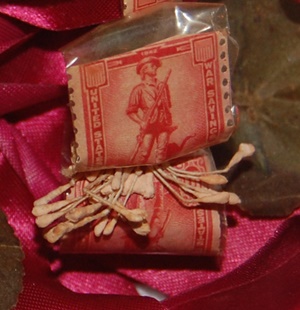
Do you know what it is?
Email your answers to: jboehling@verizon.net
Hint: Come to our Homefront Tribute and find out.
>Back to Top<
Correction!

The last issue identified this object as a sausage grinder. However, further investigation has suggested that it may be a tobacco shredder.
If you know, please let us know.
>Back to Top<
News 2017: Third Quarter
First Quarter | Second Quarter | Fourth Quarter
Home | Henrico | Maps | Genealogy | Preservation | Membership | Shopping | HCHS
|











